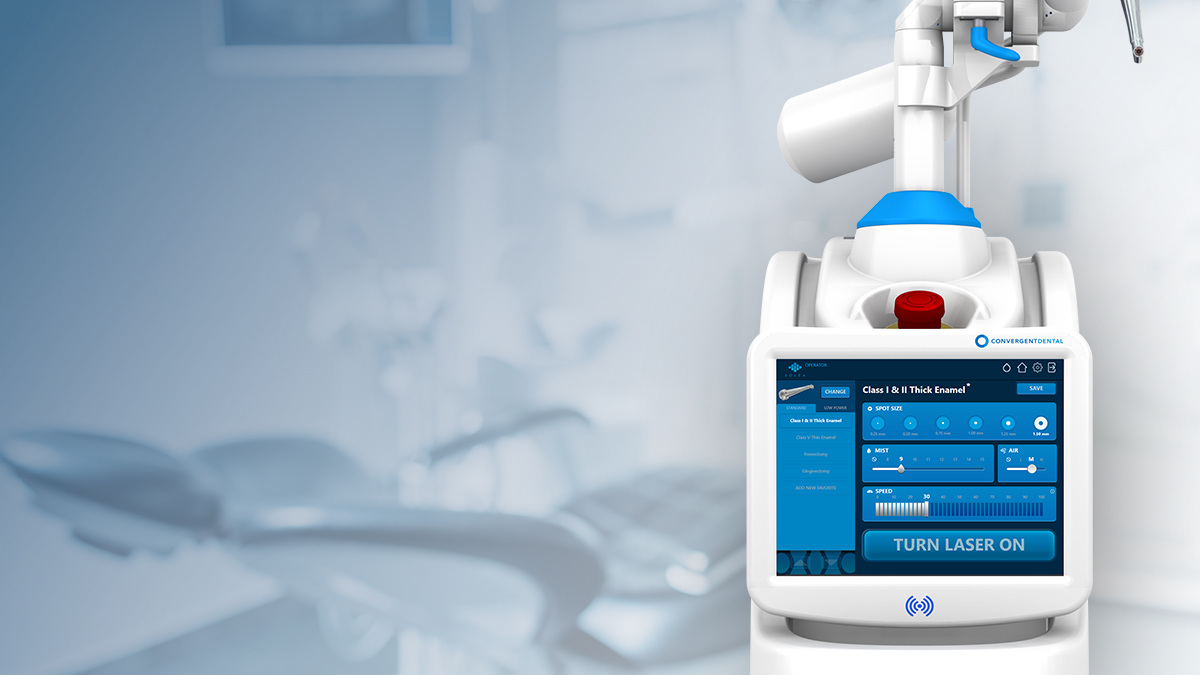We recently sat down with Robert L. Gershon, CEO of Convergent Dental, to talk about the company’s flagship product, the Solea® All-Tissue Laser. Solea is a versatile, breakthrough technology that enables procedures that are anesthesia-, blood- and pain-free, and allows you to expand into new procedures.
Q: Solea can do so much more than cavity preps. Can you share how Solea has expanded into new applications of dental care?
A: In the early days, Solea was very much thought of as a cavity machine. But it’s used for so much more than that. Dentists use Solea for so many soft tissue procedures – think gingivectomies, gingival contouring and frenectomies. They’re also using it for crown lengthening, implant uncovering and the list goes on and on.
In fact, dentists are using Solea for over 50 reimbursed codes. We’ve expanded applications to include snoring therapy using Solea Sleep, and we launched Solea Perioguide for the treatment of periodontitis. It’s a very versatile technology. Dentists that have the Solea laser are using it all day, every day, on nearly every patient.
Q: There are a few other lasers on the market. Why would a customer choose Solea?
A: The short answer is because it works. Lasers in dentistry have been around for over 40 years. The overarching promise has always been that the experience for the patient is going to be anesthesia-free and blood-free. Not delivering on that promise in the past resulted in so many doctors thinking that lasers in dentistry just don’t work. But like all technologies, lasers have evolved over time. And Solea is an illustration of that evolution. Solea does, in fact, deliver on the promise of using lasers in dentistry.
Q: What should dental practices think about when considering the adoption of Solea?
A: We know Solea is an incredibly versatile tool, but how each dentist perceives it or understands its value proposition is going to be different based on their needs. Are they trying to deliver a better patient experience that differentiates them in a competitive market? Are they looking to gain efficiencies and increase throughput? Are they trying to expand their own procedures and decrease the number of referrals they make? It’s not a one-size-fits-all. These questions really steer the conversation and help them understand, is this a fit for me? Is it a fit for me now? Is it a fit for me in the future?
Q: Once a practice decides to invest in Solea, what are some of the positive impacts they see?
A: Every practice experiences some level of increased efficiency by not having to numb patients. On average, a Solea dentist will add at minimum three to six more procedures a day, plus they can capture revenue from patients that can move from hygiene to treatment in the same visit. A story we love to tell on this front in most of us have a six-month hygiene visit. At a non-Solea practice, the story might go like this: Bad news, you have cavities, go to the reception area and schedule one to two appointments depending on the number of cavities.
In a practice with Solea, it’s a completely different conversation. You go through your routine hygiene visit, and the doctor comes in and says: Bad news, you have cavities. In fact, you have four and they’re in all four quadrants of your mouth. The good news is if you have an extra 10 to 15 minutes, we can take care of them at this visit. No need to reappoint. We’re going to use Solea. We won’t need to numb you and afterwards, you can go to lunch, go back to work, go the gym, just get on with your life, and it won’t be disruptive. Being able to capture that revenue and production immediately is a win for the practice. When you schedule follow-up visits, there’s a no-show and cancellation rate.
Also, nearly every Solea doctor will expand the procedures that they perform and reduce referrals – mostly to soft tissue procedures like frenectomies and other tethered tissue procedures. One thing we find so interesting is our highest volume users all have one thing in common – they find more uses for the technology all the time. They amaze themselves, and they share new ways of using the technology with their peers.
Q: What kind of ROI can practices expect with Solea?
A: There is a perception in the market that Solea is expensive. Solea is relatively expensive, but it’s worth it because of the ROI from a financial and a patient-experience perspective. From the financial perspective, the average Solea practice will be cash-flow positive within the first 30 days with 90 days being a longer-than-usual period.
Now, if you sit there and say, wait a minute, in 30 to 90 days, you’re going to be cash-flow positive, we’re talking about capital equipment, that doesn’t happen – it actually does. And the numbers don’t lie. When you look at adding three to six additional procedures a day, that alone generates more revenue than the monthly cost of Solea.
Q: Can you tell us about the new Solea Perioguide?
A: Dental hygienists are seeing mild to severe periodontitis all day, every day, and the prospect of offering these patients a same-day treatment to reduce their pocket depth by 50% – backed with really strong clinical data – is compelling for the doctor and patients. It’s another illustration of allowing dentists to expand into procedures they otherwise are referring out.
Q: How does Solea integrate with other technologies?
A: Solea integrates amazingly well with other digital dentistry tools, such as CBCT, milling and 3D printing. And the reason it does is because it increases efficiency and precision, leading to a better patient experience.
Being reliably blood-free when cutting in soft tissue provides for an immediate clean digital impression without the need for packing cord. Solea’s precise tissue contouring helps create accurate scans, ensuring precise 3D printing, milled restorations and even surgical guides. So the dentist, when they uncover an implant, scan and place restorations, they do it all, as you know, in the very same day.
On the blood-free front, by eliminating those delays that are caused by issues related to hemostasis or just soft tissue management in general, Solea helps the dentist achieve faster and more predictable outcomes, making it just a critical part of any truly digital practice.
I’ll add one more thing about CBCT scans. It really pairs well, especially for those that adopt Solea Sleep. Those airway practices, it really enables the dentist to be able to perform those procedures with the benefit of the CT scan that identifies the soft palate laxity that often leads to wanting to do the Solea Sleep procedure to tighten the collagen in that soft palate.
Conclusion
As Convergent Dental CEO Robert L. Gershon explains, Solea is far more than a laser – it’s a catalyst for how modern dentistry is practiced. From anesthesia-free restorative work to soft-tissue and airway applications, Solea continues to redefine what’s possible in the operatory. It delivers the experience and efficiency that today’s dental patients demand, while driving measurable business growth and clinical outcomes for the dentist.
Visit pattersondental.com to learn more about Solea.
Upcoming Webinars
November 19
Expanding Your Practice with the Solea All-Tissue Laser: More Procedures, Better Outcomes



